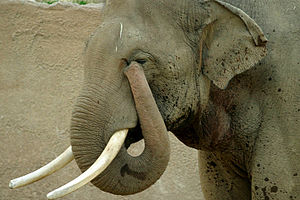Nose
Anatomically, a nose is a protuberance in vertebrates that houses the nostrils, or nares, which admit and expel air for respiration.
Function
In mammals
In most mammals, it also houses the nosehair, which catch airborne particles and prevent them from reaching the lungs. Within and behind the nose is the olfactory mucosa and the sinuses. Behind the nasal cavity, air next passes through the pharynx, shared with the digestive system, and then into the rest of the respiratory system. In humans, the nose is located centrally on the face; on most other mammals, it is on the upper tip of the snout.
As an interface between the body and the external world, the nose and associated structures frequently perform additional functions concerned with conditioning entering air (for instance, by warming and/or humidifying it) and by mostly reclaiming moisture from the air before it is exhaled (as occurs most efficiently in camels).
In most mammals, the nose is the primary organ for smelling. As the animal sniffs, the air flows through the nose and over structures called turbinates in the nasal cavity. The turbulence caused by this disruption slows the air and directs it toward the olfactory epithelium. At the surface of the olfactory epithelium, odor molecules carried by the air contact olfactory receptor neurons which transduce the features of the molecule into electrical impulses in the brain.
In cetaceans, the nose has been reduced to the nostrils, which have migrated to the top of the head, producing a more streamlined body shape and the ability to breathe while mostly submerged. Conversely, the elephant's nose has become elaborated into a long, muscular, manipulative organ called the trunk.
Human nose
The visible part of the human nose is the protruding part of the face that bears the nostrils. The shape of the nose is determined by the ethmoid bone and the nasal septum, which consists mostly of cartilage and which separates the nostrils.
Associated health risks
Because of the special nature of the blood supply to the human nose and surrounding area, it is possible for retrograde infections from the nasal area to spread to the brain. For this reason, the area from the corners of the mouth to the bridge of the nose, including the nose and maxilla, is known to doctors as the danger triangle of the face.
Shapes of the human nose
Culture
Some people choose to get rhinoplasty to change the aesthetic appearance of their nose. Nose piercings are also common, such as nostril, septum or bridge.
In New Zealand, nose pressing ("hongi") is a traditional greeting.
People famous for their noses
- Cyrano de Bergerac
- Jimmy Durante
- W.C. Fields
- Major Kovatzov in Nikolai Gogol's novel The Nose.
- Michael Jackson
- Karl Malden
- Jack Nicholson in the film Chinatown (1974) by Roman Polanski
- Barbra Streisand
References
- Physical Manual: Univ. of Tennessee at Martin
- Eden Warwick (pseudonym of George Jabet), Nasology, or hints towards a classification of Noses, London, Richard Bentley, 1848
- Encyclopedia Britannica Micropedia, 1982
See also
- Empty nose syndrome
- hooknose
- WikiSaurus:nose — the WikiSaurus list of synonyms and slang words for the nose in many languages
- sneeze
- photic sneeze reflex
- nose-picking
- nosebleed
- Little's area
- olfactory system
- mucus
- rhinoplasty
- Jala neti
- Sròn
External links
- WebMD: The Sinuses and The Nose
- From the Nose to the Eustachian Tube: Information, videos, tips for diving
- Your Nose: The Guardian Of Your Lungs
- Asian Noses This website discusses the differences in Asian noses.
- The Empty nose syndrome patient association
Template:Respiratory system Template:Human anatomical features
ar:أنف ca:Nas cs:Nos cy:Trwyn da:Næse de:Nase (Organ) et:Nina es:Nariz eo:Nazo fr:Nez ko:코 io:Nazo it:Naso (anatomia) he:אף lv:Deguns lt:Nosis mk:Нос nl:Neus ja:鼻 no:Nese pl:Nos pt:Nariz ru:Нос sq:Hunda simple:Nose sk:Nos sl:Nos fi:Nenä sv:Näsa tr:Burun (organ) zh-yue:鼻 zh:鼻

